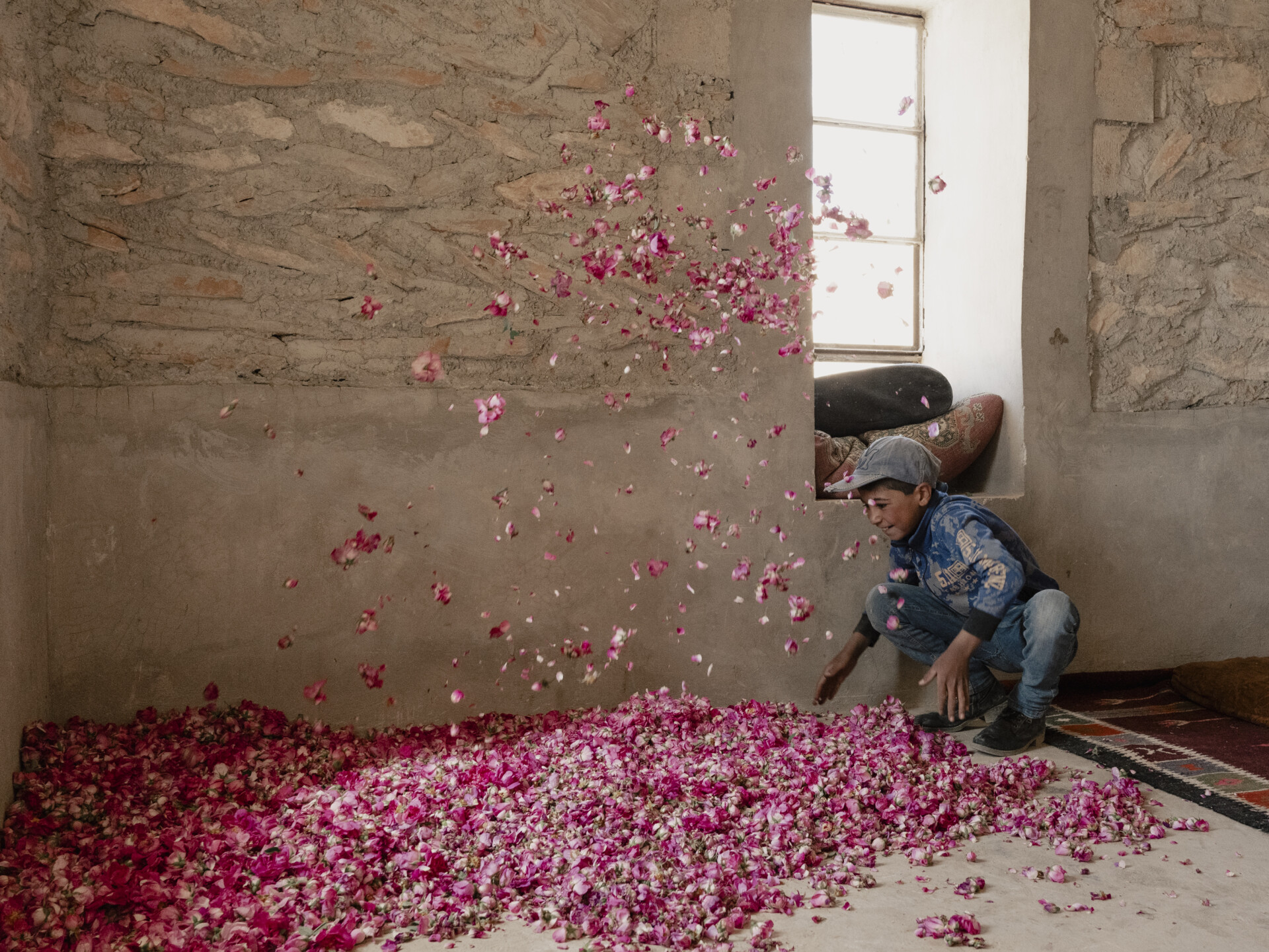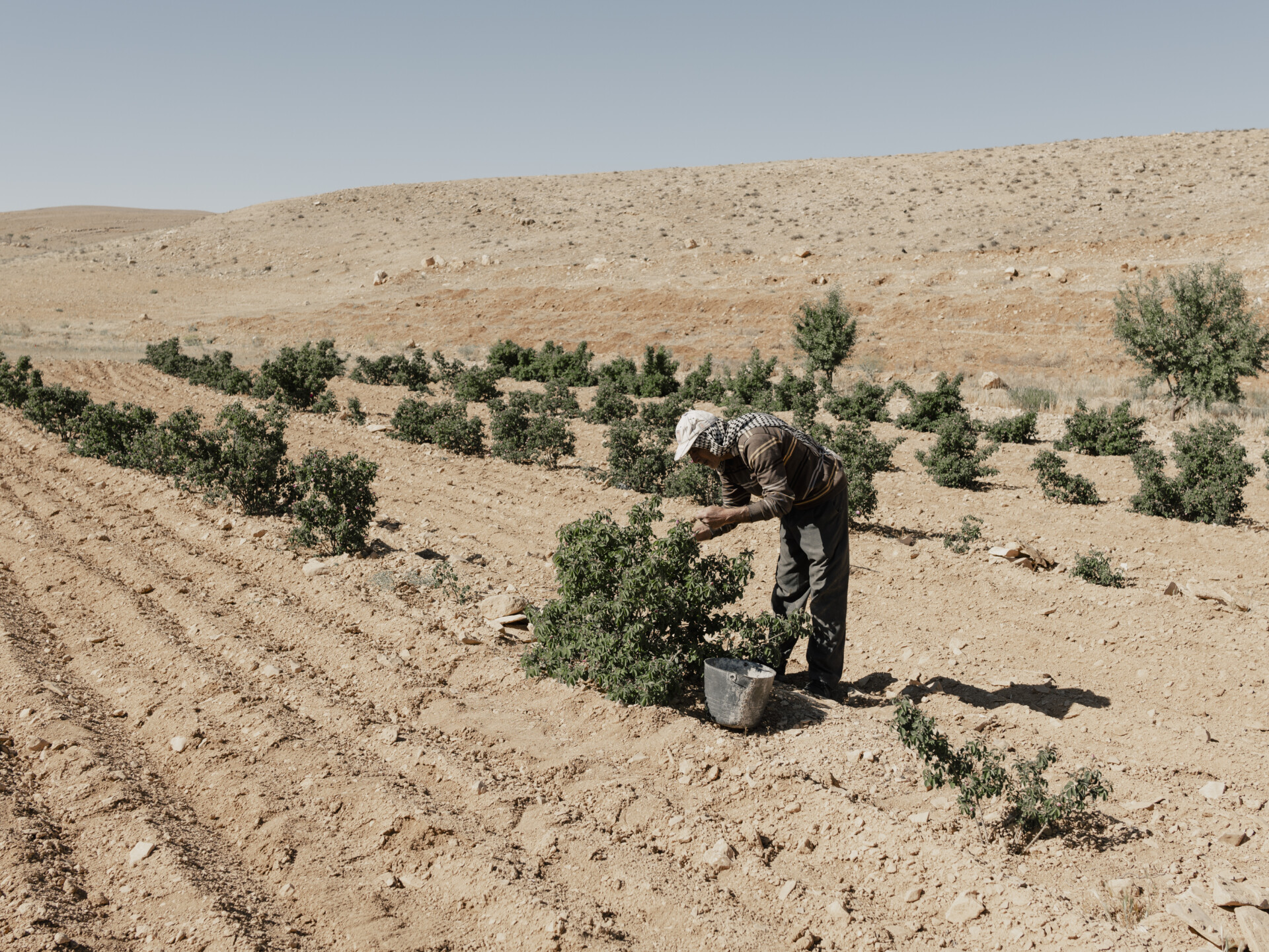The blossom looks like pink lipstick on a bare face. That’s how the color of the damask rose stands out when it blooms in the middle of the desert. In Qaldoun al-Marah, often simply called al-Marah, a village of 5,000 people 43 miles northeast of Damascus, one of the world’s oldest rose varieties is harvested between mid-May and early June. The Bitar family, one of the largest pickers of the damask rose in Syria, calls it the “queen of roses.” Also known as the Damascus or Damascene rose, its scent — intense, almost heady — suspends time. Here, where the soil is hard and the sky rarely clouds over, is where it grows best, they say.
But this beauty hides a history of loss and resilience. The rose, like all of Syria, has suffered through 14 years of war. In al-Marah, Madian Bitar, a 57-year-old farmer and son of Amin, the patriarch of the Bitars, estimates that each year at least 100 tons of roses were lost, due to the destruction of rural areas, population displacement and falling demand (in 2023 they had a surplus of 40 million flowers that the family couldn’t even sell). An estimated 50% of irrigable farmland has been razed. This was the case in the green heart of Damascus — known as the Ghouta — besieged for four years and devastated by Bashar al-Assad’s forces. Yet roses were still cultivated.
The war spared few. Farez Bassam Bitar, 18, is one of the family’s workers. He dropped out of school last year to pick roses. “My future is in this flower,” he declares, gently picking roses with bare hands.
On this June day, Farez awoke at dawn. “You have to harvest the flower while it’s still damp and has the morning dew. That preserves its scent,” he explains. He moves from one rosebush to another, picking only the flower buds so as not to damage the plant, placing them in a black basket that he empties into a bag by his motorcycle. In the distance, other workers gather flowers in the silence of the desert.
Farez didn’t fall into this profession by chance. His great-uncle, Amin Bitar, now 90, has devoted his life to the rose. Amin’s eyes are as clear as his voice, his presence at once calm and commanding. The Bitar home resembles an oasis more than a house. It’s filled with plants, with high ceilings, open windows and a cool salon with sofas that have seen generations. Here, everything is served with rose: water, tea, even a syrup of thick red color that seems to concentrate the whole flower.
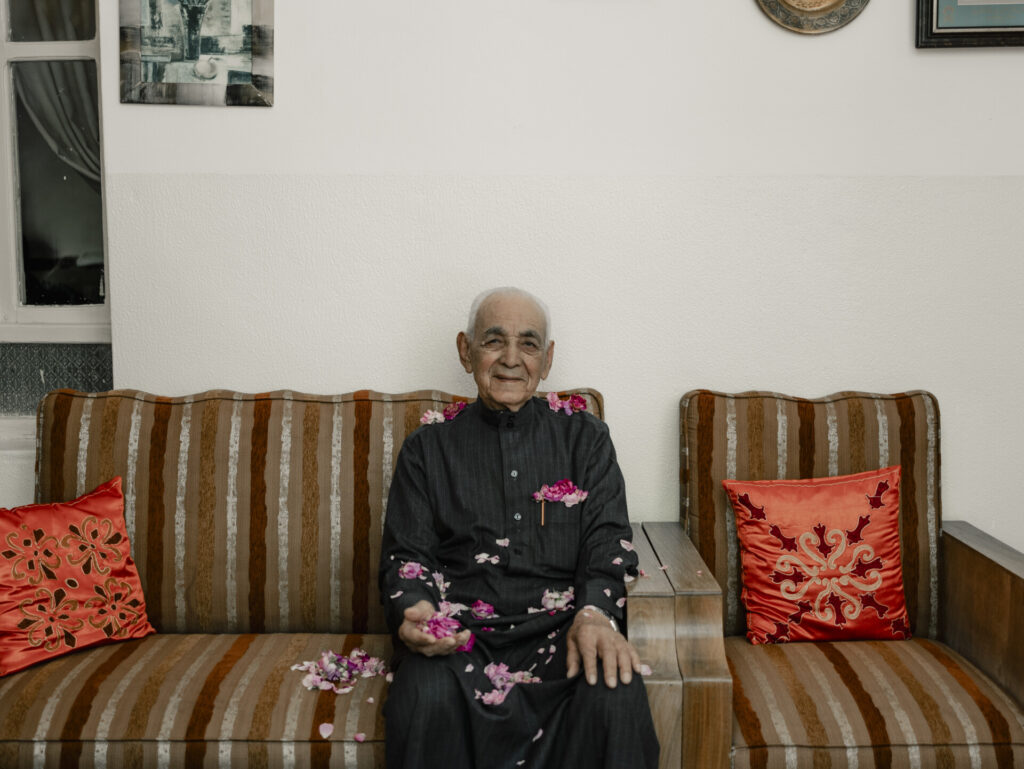
“Like apples, the rose needs a clear sky,” says Amin from his sofa, beneath a framed embroidered rose. Twenty-five years ago, you could count on one hand the number of roses grown in this village. In the 1970s, many villagers moved to the capital, Damascus, or the Gulf in search of work. There, they could make more money with less effort. “The land was worthless,” says Amin. But in the 1980s, his father began to place hope in the flower. So he bet on it.
They started planting and planting. Today, Amin says there is a love story between him and this flower. “Everything you give to the flower, it gives back. It doesn’t lie. It’s authentic,” he says.
Amin speaks proudly in Turkmen, like most of the village, recalling his grandparents and the village’s past — many here simply call the village Qaldoun, referring to a mountain in Turkmenistan. He mentions Genghis Khan with reverence: Though he never saw it himself, his empire extended to the gates of the Arab world, including Syria.
Amin’s wife, Soad, 74, echoes him with the conviction of someone who has lived her life alongside the rose. “It’s a sin if there is a single kilometer in this country where roses are not planted. The rose is our symbol. It is in everyone’s heart,” she says.
From France to Beirut, from Japan to the United States, merchants all over the world are interested in the damask rose. In Europe, it is prized for its regenerative and antioxidant properties, and is used in perfumery, cosmetics and traditional medicine. As well as Syria, it is also grown in Bulgaria, Iran, Turkey and Morocco.
Soad married Amin in 1964 when she was just 14 years old. At the time, the village had neither electricity nor running water, only gasoline lamps. “My uncle was an army officer, and he taught me that patience is a virtue. The rose taught me that too. It survives winter. It is resilient,” she says.
When she touches flower petals, it’s as if she is feeling them for the first time, she explains. The passage of time has not taken away that emotion. In 2019, UNESCO recognized the cultural practices and knowledge associated with the damask rose in the village of al-Marah as part of the “intangible cultural heritage of humanity.” The process took five years in total.
Behind the house, the family has its own distillery, where they produce rose water and oil, infusions, syrup and dried petals for export. The rose-pickers’ wisdom has been passed down through generations, in both secrecy and trust.
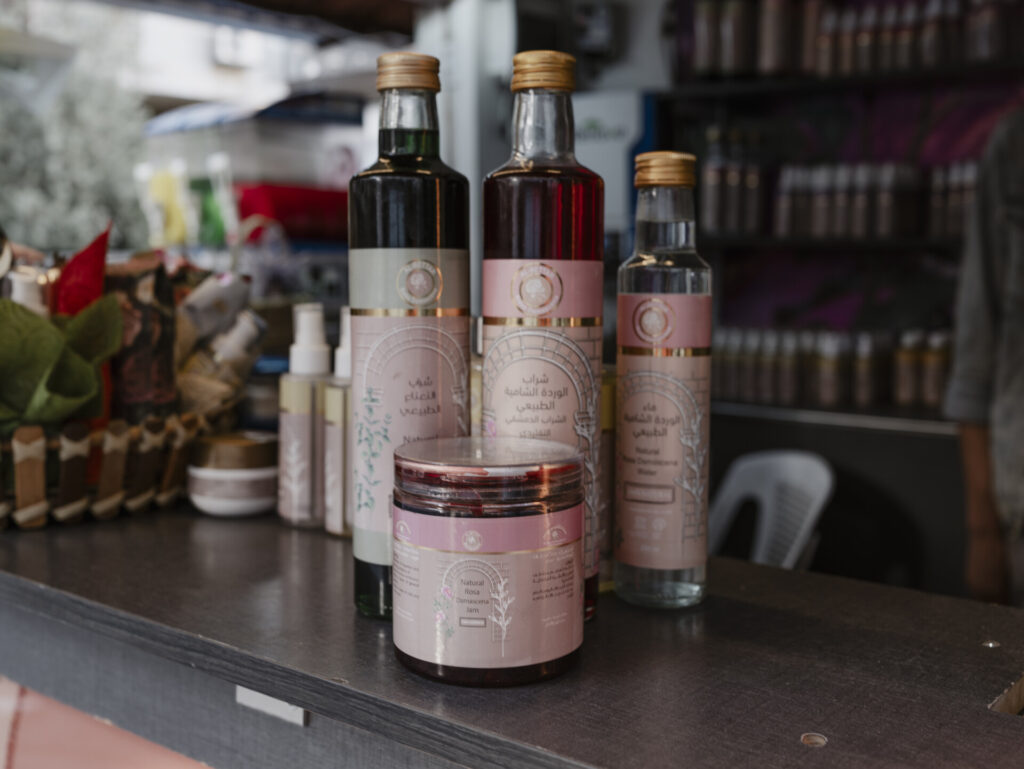
About 8 miles southwest of al-Marah, closer to the Qalamoun mountains, in the village of Maaloula, people also live to the rhythm of the rose — though there it is pressed, not distilled. The village, nestled in the mountains, feels like another world, with houses built at the foot of the mountains.
The civil war started in 2011, following peaceful protests against the Assad regime that were violently repressed, and the village was seized in 2013 by jihadist groups affiliated with the Nusra Front, which was then the local al Qaeda affiliate. Churches were looted, icons destroyed and several residents kidnapped or killed. Aramaic is spoken there — the language of the first Christians.
On the altar of the Church of Sts. Sergius and Bacchus — one of the oldest in Syria, from which icons disappeared during the war — there is a cross, two candles melted on each side, and rose petals scattered around.
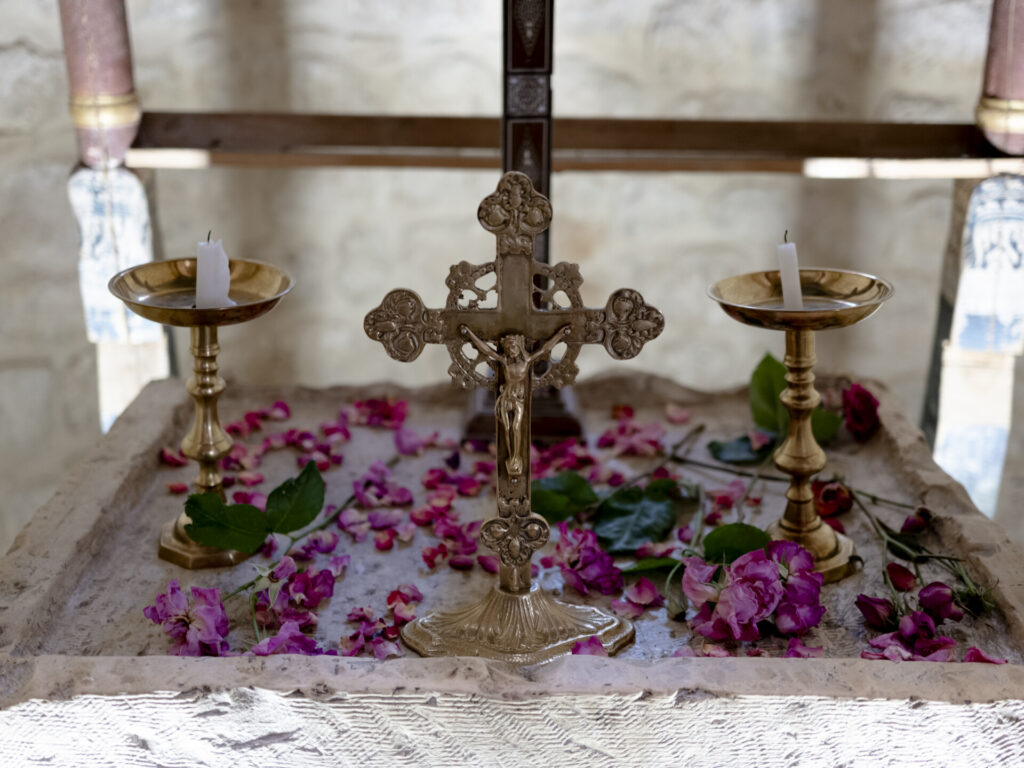
Father Fadi El Barkil, wearing a black cassock, says: “Men were created in the image of God; everything is a mirror. The rose inspires you to be as beautiful as that flower.”
In a small workshop behind the convent, a thick, almost syruplike juice is produced. In the dim room, where only a single bulb hangs from the ceiling, there are large copper vats connected by metal tubing. Fadi pours fresh petals into one of them and covers them with water, then lights a small gas burner. As it boils, the fragrant steam travels through an improvised tube and condenses into a glass container. It simmers for hours, reducing to a thick, dark-red syrup with an intense aroma. This year, the church managed to produce over 13 gallons. They sell a bottle in a neighboring cafe for 50,000 Syrian pounds, equivalent to about $5. All the syrup is made from their 150 rose bushes.
A man riding past on a motorcycle, sporting a Dalí-style mustache, remarks that he’s been cultivating the flower for 20 years. His face is sunburned. He works artisanally, maintaining 20 rose bushes to earn a little extra money.
The elixir always makes its way into the salon. In every house, every producer makes their own syrup: Sometimes it’s extremely sweet, and sometimes it only leaves a subtle aroma on the palate.
The Maaloula rose is different from that of al-Marah. Salim Rejan, the biggest producer in the village, says: “Ours is thicker, stronger. We call it the rose of Maaloula.” In al-Marah, they say the same — and that theirs is the original. Every rose grower believes theirs is best.
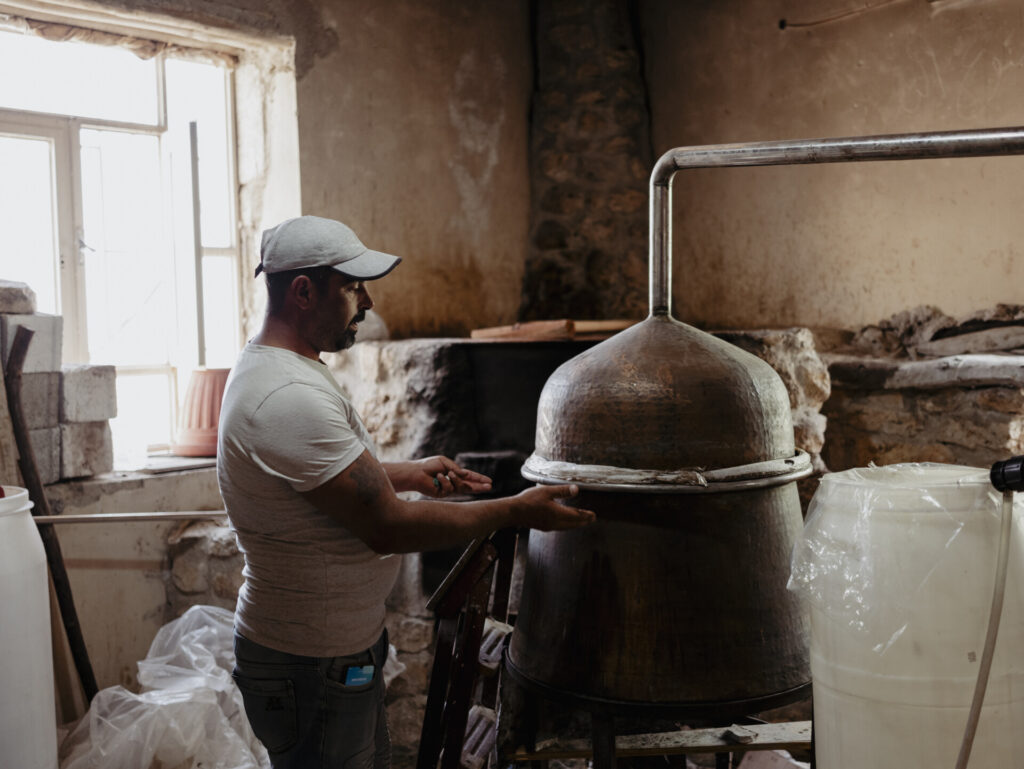
When the Nusra Front arrived in the village, many fled. Salim had to abandon Maaloula as his house was burned. The flowers were left unattended for a while, until he could return. “Growing roses requires resources,” El Barkil says. “Water, tools, hands. And here, we did not have the same support as in al-Marah.”
Back in al-Marah, a very different chapter of the rose’s story was unfolding. From a small hut in the desert, Madian, one of Amin’s sons, recalls the story that brought their village and its rose to fame.
Starting in 2002, with support from the Chamber of Agriculture, the rose began to gain visibility. In 2003, the French-Syrian Yolanda Samara of Dior took an interest in it. In 2005, the agriculture minister attended a conference at the prestigious Sheraton hotel. In 2007, Asma al-Assad, the dictator’s wife, visited al-Marah. It was a pivotal moment for the Syrian rose.
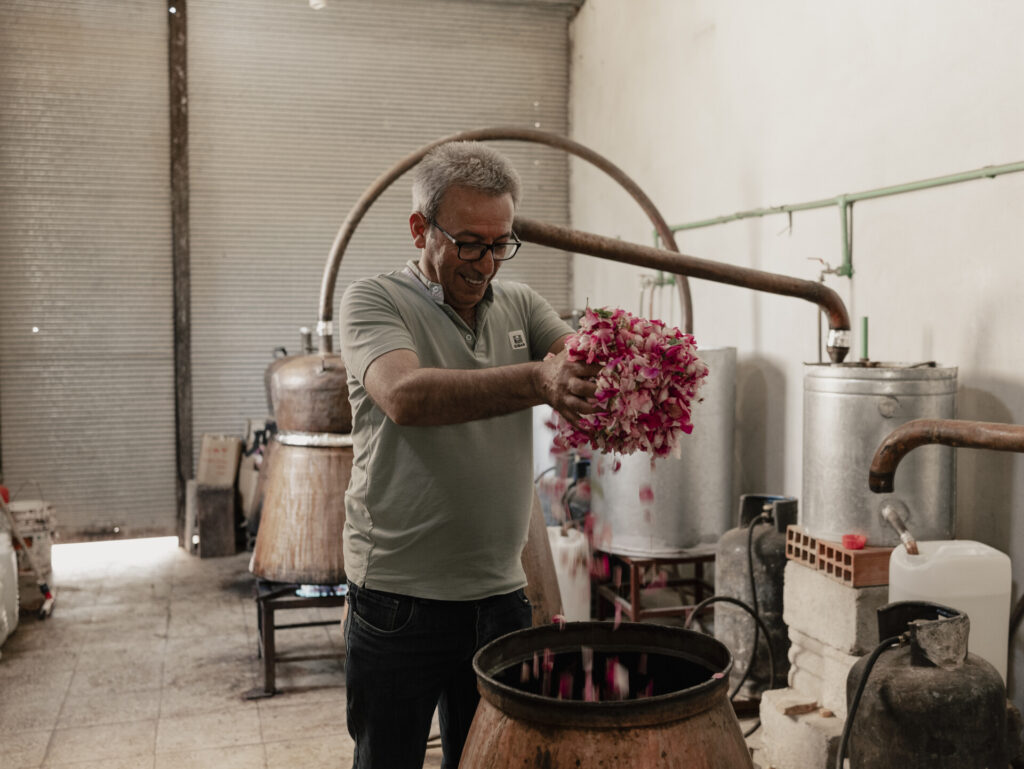
Madian, Amin’s son, recounts: “The truth must be told. Mrs. Asma helped a village that didn’t exist on the map.”
Gradually, al-Marah became a rose-tinted showcase. Asma al-Assad worked through the Amana organization, which channeled international humanitarian aid and development toward projects aligned with government interests. Two wells were built — fundamental for rose cultivation, which demands a lot of water. Madian recalls that before these, people had to bring water from Yabrud, a town 8 miles away.
After that visit, the village emerged from obscurity and rose production boomed. “People came to this village from all countries,” Madian says. When they first welcomed Asma al-Assad, they greeted her with rose water. There was no protocol. Though she was told by her security that she couldn’t drink anything, she did. The villagers did not receive any payment. Shortly afterward, they began receiving 24-hour internet access — a rare privilege in rural Syria.
At the time, Asma was seen as a modern woman. Vogue dedicated a 2011 article to her titled “A Rose in the Desert,” drawing an analogy to the flower. The article was taken offline a few weeks after publication. It had been published just as Asma’s husband’s bloody crackdown on Syrian dissidents began.
The regime began supporting an annual rose festival, which it televised and used to reinforce its image, presenting itself as close to the people, beloved and so on. “Up to 3,000 people would come in a single day. But more than a celebration, they ended up ruining the fields. The fragile plants couldn’t handle so many visitors,” says Madian bitterly.
This year, after the regime’s fall, no festival was held. But, on May 20, two people from the new Ministry of Culture came to al-Marah. One asked for roses for his villa. The other asked for scissors to cut the roses, even though they are actually picked by hand. They stayed for five minutes in the rose fields. They took selfies. When Asma al-Assad used to visit, they would let a rosebush bloom for three days so she could cut it at its peak.
After recalling that scene, Madian laughs and says: “The rose will survive. Every political group will have an interest in it. Because it is strategic.”
The most valuable product the family makes is rose essential oil — “more lasting than oil and more expensive than gold,” says Madian, who coined the phrase. He sells it for $100 per gram. The Baath Party, Syria’s official ruling party under Assad, later used the phrase as a slogan, Madian adds.
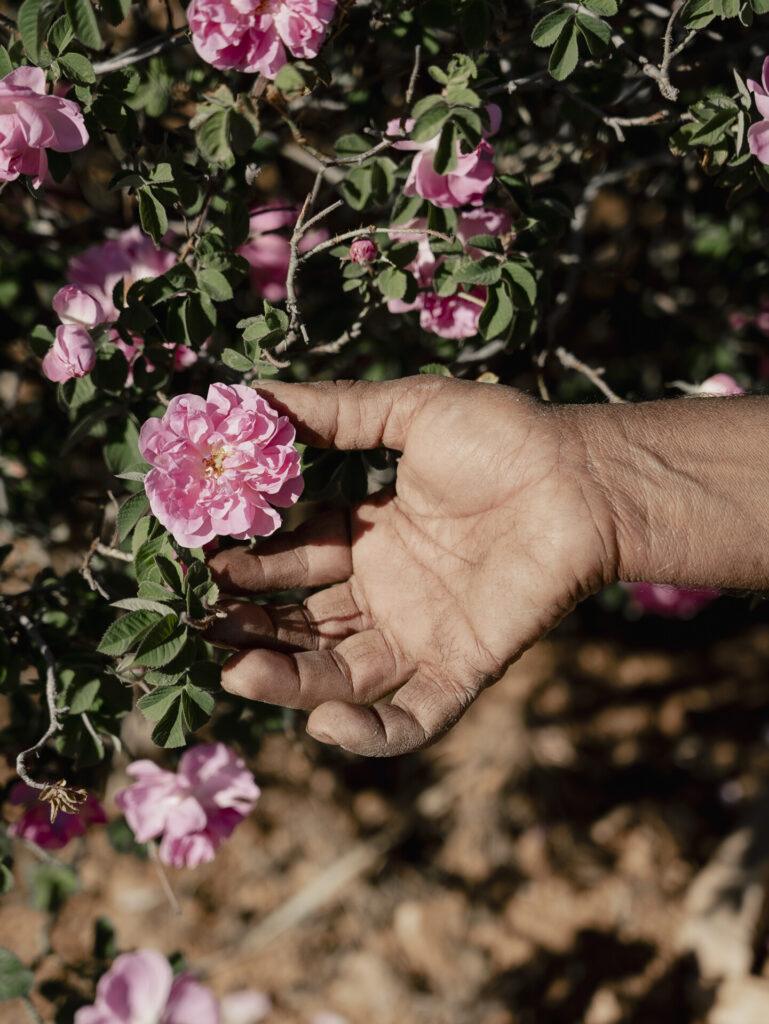
This year, the rose faces another threat in Syria: It is not blooming as healthily as before, this time because of climate change. Even in spring, the heat is oppressive. Syria is experiencing one of the most severe droughts in 50 years. “Before, it snowed in the mountains in winter; this year, nothing,” Madian says.
Walking through empty fields, he laments: “This was once a carpet of flowers. Now, there’s nothing left. Two years of work and drought took it all. … God stopped sending us rain.”
In normal conditions, a rosebush can live for up to 80 or even 100 years. But lately, residents worry about their ability to regenerate. Madian approaches the line of rosebushes, which are barely half their usual size, forcing workers to stoop over when picking. “The green should look happier,” he says.
The rose producers in al-Marah have requested new wells and solar panels to pump water using solar power. The cost is $7,000, for which they hope for support from the new government.
Soad, Amin’s wife, is worried: “If one day I wake up and the rose has disappeared, I will feel dead. And then, I will replant it again.” Elsewhere in Syria, some are still waiting for a chance to rebuild what was lost.
“Spotlight” is a newsletter about underreported cultural trends and news from around the world, emailed to subscribers twice a week. Sign up here.



